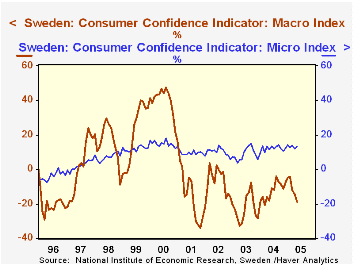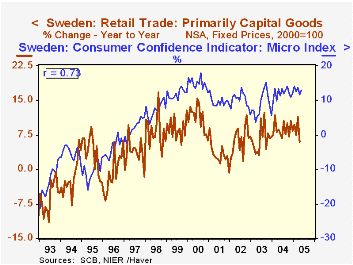 Global| May 26 2005
Global| May 26 2005Consumer Confidence in Sweden Edges Lower, but Spending on Durable Goods Remains Strong
Summary
Consumers in Sweden have been less optimistic over the past couple of months than earlier this year, according to the consumer confidence survey conducted by the National Institute of Economic Research (NIER) in Stockholm. The [...]

Consumers in Sweden have been less optimistic over the past couple of months than earlier this year, according to the consumer confidence survey conducted by the National Institute of Economic Research (NIER) in Stockholm. The resulting consumer confidence indicator ("CCI") was 5.9 in May and 6.5 in April after averaging 11.5 in Q1 2005. These are "balance" indicators, the net of "better" less "worse" responses.
The confidence survey consists of two kinds of questions, "macro" questions about the current and expected state of the Swedish economy generally and expectations about unemployment, and "micro" questions about the condition of personal finances now and expected and the willingness to make durable goods purchases. These two segments are telling very different stories. The Macro index has been negative almost continuously since early 2001, indicating a lack of confidence in the overall Swedish outlook. But people seem comfortable with their own situations, so that the Micro index has remained in a tight range averaging 12.5 over the last 15 months.
Notably, the Micro index correlates fairly well with Sweden's retail trade. Also reported today, the retail trade index from Statistics Sweden fell in April by 2.8%, but that followed a 2.2% gain in March. These sales, valued in real terms in fixed 2000 prices, are up 4.0% on a year ago. This is a bit slower than the last three years, but the store types with the less vigorous performance have been in the consumer staples area: food and personal products. The more cyclically sensitive durable goods are showing some strength, along with "household products". It is seen in the second graph that durable goods sales have a high correlation with that CCI Micro Index, 73% over the last 13 years.
So the bifurcation of the confidence data is puzzling -- how could people be worried about an unfavorable unemployment picture in the year ahead, while being fairly comfortable with their own finances? At the same time, their relative comfort with what they experience for their own financial well-being is reflected in actions they take, that is in growing purchases of durable and household goods.
| Sweden | May 2005 | Apr 2005 | Mar 2005 | Year Ago | 2004 | 2003 | 2002 |
|---|---|---|---|---|---|---|---|
| Consumer Confidence Indicator | 5.9 | 6.5 | 10.7 | 4.9 | 8.7 | 0.9 | 7.2 |
| Macro Index | -19.0 | -14.5 | -12.0 | -18.1 | -12.6 | -22.7 | -7.3 |
| Micro Index | 13.0 | 11.7 | 13.8 | 11.3 | 12.1 | 8.8 | 10.1 |
| Retail Trade (2000=100) | -- | 120.9 | 124.4 | 116.1 | 117.9 | 112.4 | 107.6 |
| % Change | -- | -2.8 | 2.2 | 4.0 | 4.8 | 4.5 | 4.6 |
Carol Stone, CBE
AuthorMore in Author Profile »Carol Stone, CBE came to Haver Analytics in 2003 following more than 35 years as a financial market economist at major Wall Street financial institutions, most especially Merrill Lynch and Nomura Securities. She had broad experience in analysis and forecasting of flow-of-funds accounts, the federal budget and Federal Reserve operations. At Nomura Securities, among other duties, she developed various indicator forecasting tools and edited a daily global publication produced in London and New York for readers in Tokyo. At Haver Analytics, Carol was a member of the Research Department, aiding database managers with research and documentation efforts, as well as posting commentary on select economic reports. In addition, she conducted Ways-of-the-World, a blog on economic issues for an Episcopal-Church-affiliated website, The Geranium Farm. During her career, Carol served as an officer of the Money Marketeers and the Downtown Economists Club. She had a PhD from NYU's Stern School of Business. She lived in Brooklyn, New York, and had a weekend home on Long Island.





